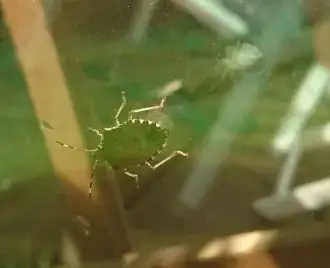This is a Shield Bug (Palomina prasina) sometimes known as stinkbug,though the actual stinkbug is a specific type, Acrosternum hilare, the North American stinkbug. By September, the new generation has matured and are more noticeable, and that's probably why there are so many of them. They suck the sap of plants, but are not usually a major issue in ordinary gardens, though they can be a significant agricultural pest. These ones will go into hibernation by November, but in the meantime, they may cause some damage if there are so many of them.
If the plants they're on are just summer bedding type plants, then for the sake of the environment, I'd ignore them. However, if they are all over permanent plants and there are significant numbers, some treatment might be appropriate, but they are difficult to treat because they move about so much. In ordinary gardens in the UK where crops are not growing, these insects are generally tolerated and left alone. They will not cause you harm, although even this variety of Shield bug has the capacity to produce an unpleasant smell if disturbed or threatened, but it's nothing like the smell the true stinkbug can produce. Some information here https://en.m.wikipedia.org/wiki/Green_shield_bug
UPDATE - In response to your comment. Shield bugs go through several development stages, usually referred to as 2nd or 3rd instar and so on. They look quite different at different stages in terms of colour and pattern and even shape initially - images in this link demonstrate that https://www.animalphotos.me/insect4/shbg-grn.htm usually finishing up, when fully mature and at the winged stage, brown or brown/grey or greenish brown.
